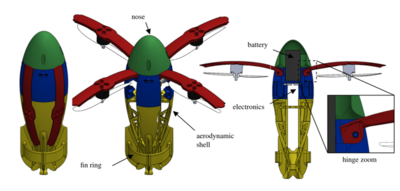Difference between revisions of "Robotics"
m (→Axel and DuAxel Rovers for extreme planetary terrains) |
m (→Locomotion Rehabilitation After Severe Spinal Cord Injury) |
||
| Line 69: | Line 69: | ||
=== Locomotion Rehabilitation After Severe Spinal Cord Injury === | === Locomotion Rehabilitation After Severe Spinal Cord Injury === | ||
| − | + | More than 250,000 people in the U.S. suffer from a major Spinal Cord Injury (SCI), and over 11,000 | |
| − | new people will be afflicted each year. Our lab collaborates with Prof. Reggie Edgerton at UCLA | + | new people will be afflicted each year. Our lab collaborates with Prof. Reggie Edgerton at UCLA |
| − | + | to develop new therapies and new technologies that hopefully one day will enable patients suffering | |
| − | therapies and new technologies that hopefully one day will enable patients suffering from SCI to | + | from SCI to partially or fully recover the ability to walk. Currently, we focus on these topics: |
| − | partially or fully recover the ability to walk. Currently, we focus on these topics: | + | |
| − | + | ||
| − | + | ||
| − | + | ||
| − | + | ||
| − | + | ||
| − | + | ||
|} | |} | ||
| Line 85: | Line 78: | ||
|- valign=top | |- valign=top | ||
| | | | ||
| + | |||
=== Recent Papers === | === Recent Papers === | ||
'''Planning in Uncertain Environments''' | '''Planning in Uncertain Environments''' | ||
Revision as of 02:42, 12 January 2021
The Burdick Group Wiki Home Page
Robotics and Spinal Cord Therapy
Burdick Research Group: Robotics & BioEngineering
|
Current and Recent Research Topics
DARPA Subterranean ChallengeWe are part of Team CoSTAR (lead by NASA/Jet Propulsion Laboratory, with partners MIT, KAIST, LTU), competing in the Subterranean Challenge (www.subtchallenge.com). See the Team's web site for the latest information. |
Axel and DuAxel Rovers for extreme planetary terrainsConventional robotic Martian explorers, such as Sojourner, Spirit, and Opportunity, have sufficient mobility to access ~60% of the Martian surface. However, some of the most interesting science targets occur in the currently inaccessible extreme terrains, such as steep craters, overhangs, loose soil, and layered stratigraphy. Access to extreme terrains on other planets (besides Mars) and moons is also of potential interest. In collaboration with JPL, we are developing the Axel and DuAxel rovers. Axel is a minimalist tethered robot that can ascend and descend vertical and steeps slopes, as well as navigate over large (relative to the body size) obstacles. In the DuAxel configuration, two Axels dock with a central module to form a self-contained 4-wheeled rover, which can then disassemble as needed to allow one or both Axels to descend into extreme terrain. The goal of this work is to develop and demonstrate the motion planning, novel mobility mechanisms, mobility analysis, and steep terrain sampling technologies that would allow Axel and DuAxel to be viable concepts for future scientific missions to extreme terrains. |
Locomotion Rehabilitation After Severe Spinal Cord InjuryMore than 250,000 people in the U.S. suffer from a major Spinal Cord Injury (SCI), and over 11,000 new people will be afflicted each year. Our lab collaborates with Prof. Reggie Edgerton at UCLA to develop new therapies and new technologies that hopefully one day will enable patients suffering from SCI to partially or fully recover the ability to walk. Currently, we focus on these topics: |
Recent PapersPlanning in Uncertain Environments
Probabilistic Search Strategies, IEEE Trans. Robotics, vol. 28, no.1, Feb. 2012, pp. 132-144.
Temporal Logic Synthesis for Uncertain Environments, Proc. IEEE Int. Conf. Robotics and Automation, May 2012, Minneapolis, MN. Dextrous Manipulation
Combined Shape, Appearance, and Silhouette for Simultaneous Manipulator and Object Tracking,Proc. IEEE Int. Conf. Robotics and Automation, May 2012, Minneapolis, MN.
Spinal Cord Injury (SCI) Rehabilitation
Recent Research TopicsHere are a some recent research topics that were actively pursued in our group.
|



